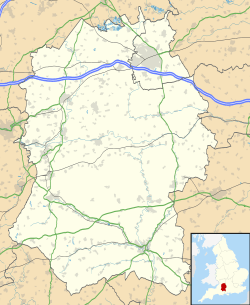Longleat Priory facts for kids
| Monastery information | |
|---|---|
| Full name | St Radegund's Priory |
| Order | Augustinian Canons |
| Established | Before 1233 |
| Disestablished | 1529 |
| Mother house | A "peculiar" under the control of the Dean of Salisbury |
| Dedicated to | St Radegund |
| Diocese | Diocese of Salisbury |
| Controlled churches |
|
| People | |
| Founder(s) | Sir John Vernon (thought to be) |
| Site | |
| Location | Longleat, United Kingdom |
| Coordinates | 51°11′09″N 2°16′27″W / 51.1857°N 2.2743°W |
| Visible remains | Incorporated into the cellars of Longleat House |
Longleat Priory was an old religious building near Warminster, in Wiltshire, England. A smaller, short-lived priory existed nearby in the 1100s. The main priory started before 1233. It was overseen by the Dean of Salisbury, a church leader, until it closed down in 1529. Today, the famous Longleat House stands where the priory once was.
Contents
The Priory's Story
Early Beginnings
The first group of Augustinian canons (who were like monks but followed a different rule) settled in the 1100s. They built a small priory dedicated to Saint Mary at Langley, about two miles from where Longleat House is now. This first priory didn't last long. After it closed, its land was given to Cirencester Abbey.
A second, more lasting priory was built at Longleat. It was dedicated to St Radegund. This happened sometime before 1235, but the exact date isn't known. Sir John Vernon is believed to have founded this priory. He gave it land in Selwood Forest and four acres in Ansty.
Growing and Earning Money
By 1257, the priory had gained land at "Baycliff in Horningsham." By 1291, it owned more land in Longleat and Stourton in Wiltshire. It also had land in Batcombe, Laverton, Lullington, and Nunney in Somerset. In 1291, these lands brought in an income of £5 17s. 7d.
In 1324, Robert le Bor gave more land to the priory. This land was in Ansty, Codford, Hill Deverill, Horningsham, Longbridge Deverill, and Warminster.
Financial Challenges
Longleat Priory seems to have been quite small. It often struggled with money. During the time of King Richard II (1377–1399), the priory had a prior (the head of the priory), Richard Axebridge, and five other canons. However, the priory's income was not enough to support even this small group.
To help with money problems, the priory tried new ways to get funds. In 1402, it was allowed to offer an "indulgence" to people who donated money. This meant the prior and priests would hear the donors' confessions if they gave money for repairs.
The priory also kept getting more land and gifts. In 1393, it gained control of the church at Lullington, Somerset. In 1407, Sir Walter Hungerford gave the priory the right to choose the priest for the church in Rushall, Wiltshire.
Unique Control
Longleat Priory didn't have a "motherhouse" (a larger monastery it reported to). Instead, it was a "peculiar." This meant it was directly controlled by the Dean of Salisbury. The Dean had the final say over the priory. He even had to approve the canons' choice when they elected a new prior.
John Chandler, who was Dean and later Bishop of Salisbury, visited the priory on October 1, 1408. Four years earlier, he had approved Peter Sampson as the new prior. Chandler wrote that "all was well" at the priory during his visit. At that time, there were the prior and four canons living there.
The Priory's End
Closing Down
By the 1500s, the priory's money problems became too big. Longleat Priory was closed down in 1529. This happened six years before King Henry VIII started dissolving many smaller monasteries in 1535.
The priory's land and property were sold or given to Hinton Priory, another religious house in Somerset. In 1534, it was noted that Longleat's former lands provided Hinton Priory with an income of £21 16s 8d.
New Owners
In 1539, Hinton Priory itself was closed down. Sir Walter Hungerford, who was the steward of Hinton Priory, hoped to get the Longleat site. However, he didn't succeed.
In 1540, the former priory land was given to Sir John Horsey. Then, it went to Edward Seymour, 1st Earl of Hertford. In June 1541, he sold the land to Sir John Thynne for £53. Sir John Thynne was an ancestor of the Marquesses of Bath.
Longleat House Today
By 1546, the site became a private home. It's not clear how much of the old priory building was used in this new house. This building burned down in 1568. A new building, which is the current Longleat House, was built before 1580. It must have been mostly finished by 1574, as Queen Elizabeth I visited it with her court that year. The last parts of the old priory are now part of the cellars of Longleat House.
Known Priors of Longleat
Here is a list of some of the known Priors (leaders) of Longleat. This list is not complete, as not all of them are known.
- Richard, around the time of King Henry III (1216–1272)
- William, in 1322
- Henry, in 1334
- Richard Axebridge, in 1381
- John Frome, died in 1404
- Peter Sampson, elected in 1404 and still prior in 1408
- John Pert, in 1419
- John Mapull, in 1489–90
- John Hore, in 1498
- Thomas Pumbery, in 1518


